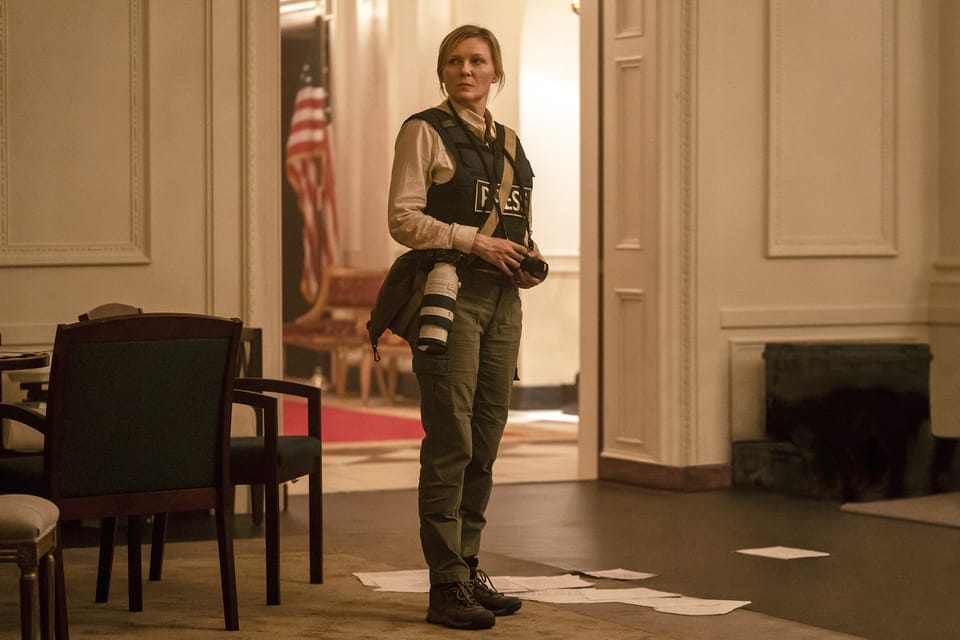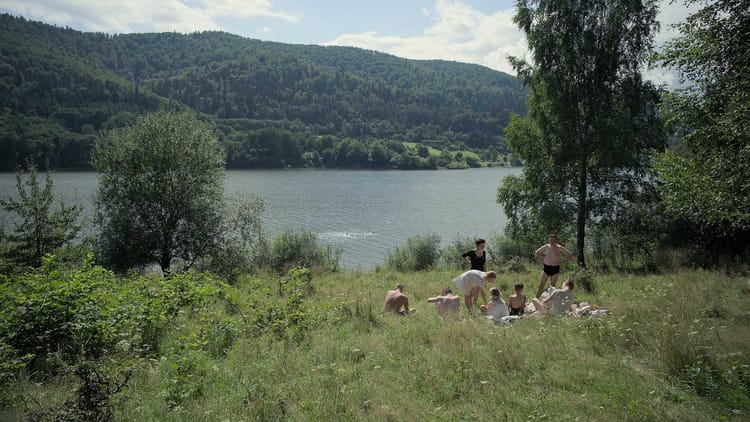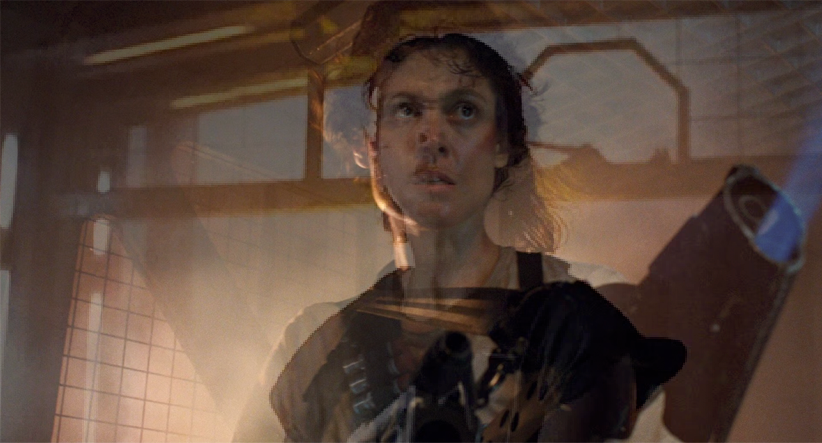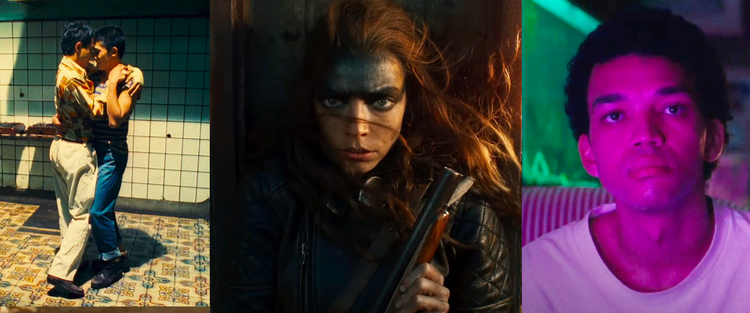Civil War: What We've Got Here is Failure to Communicate

Greetings! This week's entry has been looming large on the calendar for a while. I was extremely skeptical about Civil War, as I thought Alex Garland's last movie Men was a clear step down from Ex Machina and especially Annihilation. The enthusiastic early reviews caught me off guard, and so going in I didn't know what to expect. It produced some very mixed feelings, though it did have the effect of making me appreciate Men more.
The Discourse surrounding Civil War since the release of its trailer was that the contours of its war made no sense. A scenario where Texas and California work together against federal government Loyalists is as hard to imagine as any state joining a Florida Alliance. Now that the movie is out the factions still don't make sense, but it turns out that is... not "not a problem," but not a fatal one. For writer-director Alex Garland is much less interested in exploring or explaining the cause and meaning of a second United States civil war, than conveying the subjective, psychological, sensory experience of being in a war zone, specifically as a non-combatant journalist who frequently has to negotiate the ethics of their job. Garland succeeds at conveying that, but one's opinion of the movie will depend largely on whether one shares his priorities. For me the conspicuous absence of any real context makes Civil War an experience both nerve-wracking and enervating.
The story takes place in the waning days of a war between the Loyalists and the California-Texas Western Forces. (The Florida Alliance doesn't really matter, and there is an entire northwest New People's Army that is so irrelevant I only learned about it reading about the movie afterward.) The WF is making its final push toward Washington, DC and photojournalist Lee Smith (Kirsten Dunst) and regular journalist Joel (Wagner Moura) want to get there and interview the President (Nick Offerman) before he's deposed. They're joined by their old friend Sammy (Stephen McKinley Henderson), a writer for "what's left of the New York Times" and Jessie (Caelee Spaeny), an aspiring photojournalist who idolizes Lee and joins them in order to get some real experience. The eastern corridor from New York to DC is impassable, however, so they have to swing around southwest and then head for the front in Charlottesville, a detour fraught with danger, and photo ops.
The movie is not coy about the contemporary inspiration for this scenario. It opens with Offerman's unnamed President rehearsing different bombastic opening lines for a press conference, intercut with real-life footage of clashes between police and protesters from the 2020 George Floyd demonstrations. It's not clear if this takes place in the near future—there is no new technology and things like Wikipedia are still around—or an alternate present. Either way, the use of the real footage makes explicit its intention to take the shock and awe of those dark days and imagine if it had been even worse.
It does this by being above all overwhelming. The sound design is a cacophony of gunfire, the low-rumbling pops of distant ambiance being spiked with the jolting decibels of every shot that goes off in the near vicinity. Garland's direction of the action splits the difference between god's-eye view money shots of destruction, and the chaos as experienced on the ground. The photojournalist angle of the story feels genuinely new for a modern war film, anchoring its tense firefights with characters who shoot with cameras instead of rifles, and as such have no defense beyond their Press insignia. The way threats cannot be neutralized, only be avoided, makes war feel terrifying in a way Truffaut might have approved.
The early connection made to the unrest of 2020 also serves to revive the era's background anxiety. Each new stopover that the characters make channels the uncertainty of that period, of wondering what terrible new development the day would bring and how much you could trust a random stranger. There are moments, especially in the back end when the characters reach DC, that practically recreate episodes like the chopper dusting Black Lives Matter protesters or the January 6, 2021 sack of Congress. I spent much of this movie re-experiencing sense memories of those bad old days, the constant simmering fear that things were going to go from bad to worse, and the sensation left me utterly drained.
Viewers will have very different memories of those events and their significance. Garland wants them to leave all that baggage at the theater door, and so he has, in theory, engineered the setting to resist any kind of political reading. The choice of California and Texas as the WF states, the refusal to explain what any of the fights are about, the President being such a nonentity that he doesn't have a stated party or even a name; these are all intended to defuse any politically incendiary topics or stances that would lead the audience to 'taking sides.' This is successful insofar as the nature of its conflict is inscrutable. As for whether it actually allows viewers to put politics aside, the fact that Garland weighed in on California-Texas by blaming the audience says a lot.
Honestly, so much of this misunderstanding could have been avoided if the states had just not been named at all. If Garland did not want people fixating on why California and Texas are working together, if he truly wanted us to view a war-torn America as a slaughterhouse where political persuasions and ideologies have all the righteousness of a butcher's blade, then he shouldn't have sprinkled his script with all these loaded signifiers to nowhere. If you don't want your audience to expect to be spoon fed, don't wave the damned spoon in front of their faces.
It's not like the movie is fully neutral on its conflict. For if all sides in this civil war are equally bad, some are more equal than others. We are given enough information to conclude the President is 'unambiguously' bad: he's serving an unconstitutional third term, launched attacks on American citizens, has journalists killed; he's even compared to Ghadaffi, Saddam, and Nicolae Ceaușescu. I use the scare quotes because even—especially—the most self-evidently evil acts can and will be rationalized away by the people who carry them out. Given this information it's only natural to want to know how a president and his supporters would justify them. Asking how a movie's characters give themselves moral permission to carry out atrocities is not the same thing as asking the filmmaker for that same permission.
However clunkily the movie's efforts to distance itself from the reasons for the war, it is consistent with its emphasis on the immediate experience of its characters. Who is fighting whom and why, after all, are of little practical importance to a photographer who is just trying to get their shot without getting shot. It is this focus that, for all my gripes with what Civil War isn't, makes it more than just empty provocation, fixated as it is on the occupational and spiritual hazards journalists face, the risk that in covering a war they become part of it.
Lee and Jessie are essentially on orthogonal tracks. Jessie, green and naive, has to numb herself to the danger and violence around her. Meanwhile Lee, who Dunst infuses with weary worldliness, suffers increasingly intrusive memories as a career's worth of dissociated death catches up with her. Both wrestle with (to quote Susan Sontag for the second week in a row) their cameras' ability "to catch a death actually happening and embalm it for all time." The mind goes easily to Kevin Carter's 1994 photo of a vulture stalking a starving Sudanese child, and the questions it raised about what responsibility a documentarian of horror has to halt it. This is not accidental; Lee's most traumatizing memory, one of the most appalling moments in the movie, specifically recreates one of the too many horrific deaths that Carter witnessed that led to his suicide.
I didn't have space to mention it last week, but Apocalypto has a scene where the hero stumbles into a killing field ankle-deep with corpses. There's a similar moment here, but the different emotional registers are instructive. While the former scene is functionally horror, its spectacle gives it an insidious charge, its grandiose evil giving purpose to the hero's own ruthlessness. Here there is nothing to be salvaged from exposure to incomprehensible mass murder. The scene and the larger sequence it is part of shatters everyone involved, killing them figuratively if not literally. The tendency in edgy grimdark media to revel in its awfulness is absent in Civil War, a major point in its favor and maybe even that of the movie's depoliticization.
Where the focus on war journalism falls short is, weirdly enough, on how it is actually informing others. There is little if any discussion between Lee and company about what gets covered and what gets left out, and how that may shape perceptions of what they are covering and in turn shape the thing itself. Lee is in the beginning scenes already disenchanted in her work's capacity to warn Americans away from the horrors of war, and the adrenaline junkie aspect of all the characters' increasingly dangerous exploits is explicitly acknowledged. But neither the characters nor the movie itself are interested in how words and images are used after they are released into the world.
The movie does highlight the importance of media context, albeit accidentally. A row erupted on what's left of the site formerly known as Twitter, over the movie sourcing some of its riot footage from Andy Ngo (as well as noted anti-trans activist Helen Lewis). Ngo's entire shtick is to selectively frame and edit information and footage to portray various leftist and left-of-center figures as depraved, violent antifa savages, in order to incite and justify harassment and threats against individuals and riots by fascist street gangs. The inclusion of his footage demonstrates better than anything else in Civil War that an image or story doesn't speak for itself, that context matters. Garland isn't a crypto-Nazi. The imperative to find the most shocking footage possible for his movie about the gruesome reality of killing your countrymen, however, led to including and acknowledging the contributions of a man who runs interference for people who openly fantasize about throwing their enemies from helicopters into the sea.
It's simply not possible to get away from politics when discussing a civil war, and arguably not even desirable. A civil war is the result of a breakdown in the terms of the social contract, the death of national politics, and showing scene after scene of people slaughtering their neighbors while not deigning to explain why feels if not cowardly, as I thought in my initial response–then insufficient.
It is possible that the people most eagerly clamoring for violence, the QAnon death cult, the militias and Proud Boys, the plotters against America at the Claremont Institute, could see Civil War and have second thoughts about where they want to lead the country.[1] A visceral, emotional appeal to stop the slide toward mere anarchy has a far better chance of changing hearts and minds than a polemic or explainer. It could happen. But it's probable that many if not most of those who Alex Garland wants to reach are already too far gone. The Day of the Rope is not a means to an end but an endtimes vision of spiritual renewal through cathartic bloodletting. The cruelty is the point. The people that are actively working to subvert the electoral process will not be reasoned with, they need to be opposed and stopped. As vividly as Garland is able to depict civil wars and the effects on their populations, it's hard to shake the sense that a movie with so little concern for why they start is in any place to prevent one from doing so.
If I wanted to do the both-sides thing I could also name the Revolutionary Communists, whose satellite organization Refuse Fascism was a mainstay of Trump-era protests, but that's frankly disingenuous. There's a reason Kyle Rittenhouse is a folk hero on the right and I had to look up an article about Michael Reinoehl just to recall his name. Whatever the posture of revolution and the keyboard communist shitposting about putting people up against the wall, the actual far left in this country has no equivalent in political influence, resources, and operational organization as the likes of Marjorie Taylor Greene, Peter Thiel, Steve Bannon, and Chris Rufo. ↩︎





Member discussion